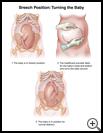
External Repositioning of the Baby during Pregnancy
________________________________________________________________________
KEY POINTS
- External repositioning is a way to try to change your baby's position in your uterus before the baby is born. Usually it is done to turn a breech baby to a better position for delivery. A breech position means that the baby's bottom or feet will come out before the head when the baby is born. The baby’s head may get stuck inside the uterus, and the baby could be injured or even die.
- For this procedure, you will lie on your back. Your healthcare provider will put their hands on your belly and find the baby's head. Your provider will then gently press on your belly to push the baby into a headfirst position.
- Ask your provider how to take care of yourself at home. Make sure you know what symptoms or problems you should watch for and what to do if you have them.
________________________________________________________________________
What is external repositioning?
External repositioning is a way to try to change your baby's position in your uterus before the baby is born. Usually it is done to turn a breech baby to a better position for delivery. In a breech position, the baby's bottom or feet will come out before the head when the baby is born. This is risky because the baby's head could get trapped in the mother's cervix (the opening of the uterus). It could make a vaginal delivery dangerous or impossible. Moving the baby to a position where the baby’s head will come out first may let you have a normal vaginal delivery.
When is it used?
If your baby is in a breech position, your healthcare provider may try to turn the baby to a head-first position after about 36 weeks of pregnancy. Your healthcare provider may find that the baby is breech by feeling the baby's head through your belly or by feeling your baby’s feet or bottom during a pelvic exam. Your provider may hear the baby's heartbeat above your belly button rather than in your lower belly.
An ultrasound exam, which uses sound waves to show pictures of the baby, can show the size and position of the baby.
What happens during the procedure?
This procedure may be done at a place where an emergency C-section can be done if needed. A C-section is an operation that delivers your baby through a cut in your belly and uterus.
Just before the procedure, you may have:
- An ultrasound scan, which uses sound waves to show pictures of the baby in your uterus
- A nonstress test, which uses a monitor strapped to your belly to record how your baby's heart rate changes when the baby moves
You may be given medicine to relax your uterus. Sometimes the lower half of your body may be numbed with medicine given into your spine (epidural anesthesia).
You will lie on your back. Your healthcare provider will put their hands on your belly and find the baby's head. Your provider will then gently press on your belly to push the baby into a headfirst position.
What happens after the procedure?
After the procedure you may stay in a recovery area for a few hours until the anesthesia wears off. You will have another nonstress test to check the baby.
If the procedure is successful, you may be able to have a normal vaginal delivery. If your healthcare provider is not able to turn the baby, your provider will talk to you about your choices for delivery. You will discuss the risks and benefits of delivering a breech baby vaginally compared with the risks and benefits of a C-section.
Follow your healthcare provider's instructions. Ask your provider:
- If there are activities you should avoid and when you can return to your normal activities
- How to take care of yourself at home
- What symptoms or problems you should watch for and what to do if you have them
Make sure you know when you should come back for a checkup.
What are the risks of this procedure?
Every procedure or treatment has risks. Some possible risks of this procedure include:
- Problems with anesthesia
- Going into labor early
- Early breaking of the bag of water
- Damage to the placenta, which could cause part or all of it to tear away from the uterus before delivery
- The need for an emergency C-section if your baby may not be getting enough oxygen due to a pinched or twisted umbilical cord
Ask your healthcare provider how these risks apply to you. Be sure to discuss any other questions or concerns that you may have.

